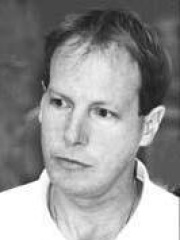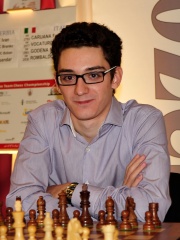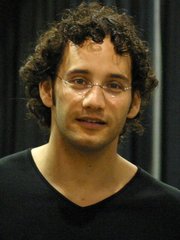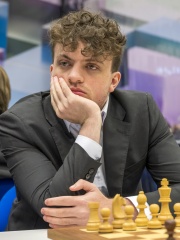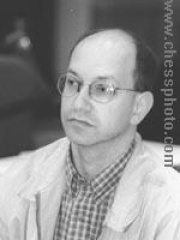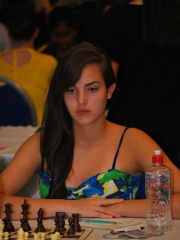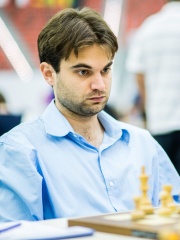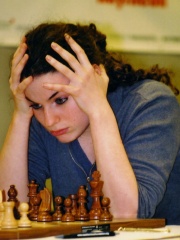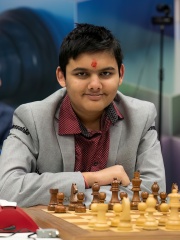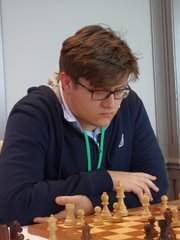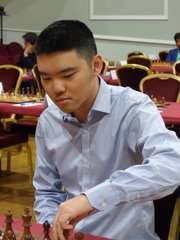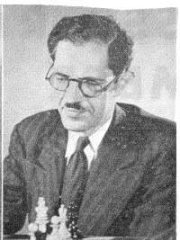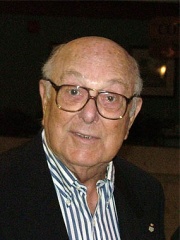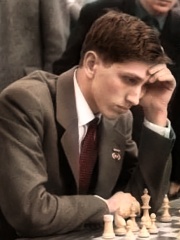
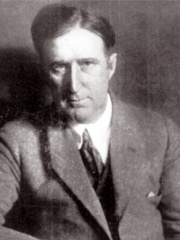
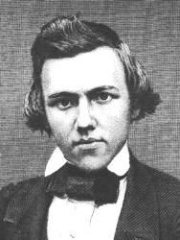
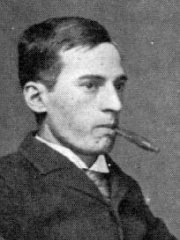
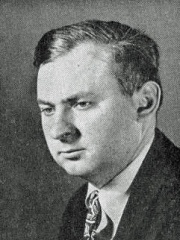
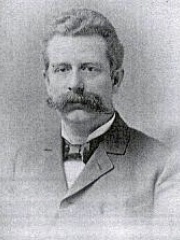
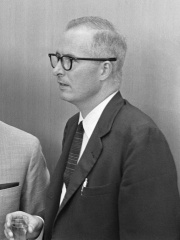
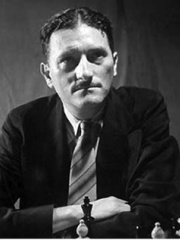
The Most Famous
CHESS PLAYERS from United States
This page contains a list of the greatest American Chess Players. The pantheon dataset contains 461 Chess Players, 24 of which were born in United States. This makes United States the birth place of the 4th most number of Chess Players behind Ukraine, and Hungary.
Top 10
The following people are considered by Pantheon to be the top 10 most legendary American Chess Players of all time. This list of famous American Chess Players is sorted by HPI (Historical Popularity Index), a metric that aggregates information on a biography's online popularity. Visit the rankings page to view the entire list of American Chess Players.

1. Bobby Fischer (1943 - 2008)
With an HPI of 78.36, Bobby Fischer is the most famous American Chess Player. His biography has been translated into 95 different languages on wikipedia.
Robert James Fischer (March 9, 1943 – January 17, 2008) was an American chess grandmaster and the eleventh World Chess Champion. A chess prodigy, he won his first of a record eight US Championships at the age of 14. In 1964, he won with an 11–0 score, the only perfect score in the history of the tournament. Qualifying for the 1972 World Championship, Fischer swept matches with Mark Taimanov and Bent Larsen by 6–0 scores. After winning another qualifying match against Tigran Petrosian, Fischer won the title match against Boris Spassky of the USSR, in Reykjavík, Iceland. Publicized as a Cold War confrontation between the US and USSR, the match attracted more worldwide interest than any chess championship before or since. In 1975, Fischer refused to defend his title when an agreement could not be reached with FIDE, chess's international governing body, over the match conditions. Consequently, the Soviet challenger Anatoly Karpov was named World Champion by default. Fischer subsequently disappeared from the public eye, though occasional reports of erratic behavior emerged. In 1992, he reemerged to win an unofficial rematch against Spassky. It was held in Yugoslavia, which at the time was under an embargo of the United Nations. His participation led to a conflict with the US federal government, which warned Fischer that his participation in the match would violate an executive order imposing US sanctions on Yugoslavia. The US government ultimately issued a warrant for his arrest; subsequently, Fischer lived as an émigré. In 2004, he was arrested in Japan and held for several months for using a passport that the US government had revoked. Eventually, he was granted Icelandic citizenship by a special act of the Althing, allowing him to live there until his death in 2008. During his life, Fischer made numerous antisemitic statements, including Holocaust denial, despite his Jewish ancestry. His antisemitism was a major theme in his public and private remarks, and there has been speculation concerning his psychological condition based on his extreme views and eccentric behavior. Fischer made many lasting contributions to chess. His book My 60 Memorable Games, published in 1969, is regarded as essential reading in chess literature. In the 1990s, he patented a modified chess timing system that added a time increment after each move, now a standard practice in top tournament and match play. He also invented Fischer random chess, also known as Chess960, a chess variant in which the initial position of the pieces is randomized to one of 960 possible positions.

2. Frank Marshall (1877 - 1944)
With an HPI of 71.64, Frank Marshall is the 2nd most famous American Chess Player. His biography has been translated into 38 different languages.
Frank James Marshall (August 10, 1877 – November 9, 1944) was the U.S. Chess Champion from 1909 to 1936, and one of the world's strongest chess players in the early part of the 20th century.

3. Paul Morphy (1837 - 1884)
With an HPI of 71.03, Paul Morphy is the 3rd most famous American Chess Player. His biography has been translated into 57 different languages.
Paul Charles Morphy (June 22, 1837 – July 10, 1884) was an American chess player. During his brief career in the late 1850s, Morphy was acknowledged as the world's greatest chess master. Later commentators have concluded that he was far ahead of his time. A prodigy, Morphy emerged onto the chess scene in 1857 by convincingly winning the First American Chess Congress, winning each match by a large margin. He then traveled to Europe, residing for a time in England and France while challenging the continent's top players. He played matches with most of the leading English and French players, as well as the German Adolf Anderssen—again winning all matches by large margins. In 1859, Morphy returned to the United States, before ultimately abandoning competitive chess and receding from public view.

4. Harry Nelson Pillsbury (1872 - 1906)
With an HPI of 60.22, Harry Nelson Pillsbury is the 4th most famous American Chess Player. His biography has been translated into 26 different languages.
Harry Nelson Pillsbury (December 5, 1872 – June 17, 1906) was a leading American chess player. At the age of 22, he won the Hastings 1895 chess tournament, one of the strongest tournaments of the time, but his illness and early death prevented him from challenging for the World Chess Championship.
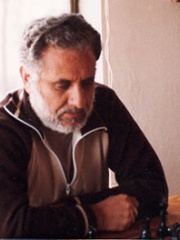
5. Larry Evans (1932 - 2010)
With an HPI of 59.62, Larry Evans is the 5th most famous American Chess Player. His biography has been translated into 16 different languages.
Larry Melvyn Evans (March 22, 1932 – November 15, 2010) was an American chess player, author, and journalist who received the FIDE title of Grandmaster (GM) in 1957. He won or shared the U.S. Chess Championship five times and the U.S. Open Chess Championship four times. He wrote a long-running syndicated chess column and wrote or co-wrote more than twenty books on chess.

6. Reuben Fine (1914 - 1993)
With an HPI of 58.96, Reuben Fine is the 6th most famous American Chess Player. His biography has been translated into 29 different languages.
Reuben C. Fine (October 11, 1914 – March 26, 1993) was an American chess player, psychologist, university professor, and author of many books on both chess and psychology. He was one of the strongest chess players in the world from the mid-1930s until his retirement from chess in 1951. He was granted the title of International Grandmaster by FIDE in 1950, when titles were introduced. Fine's best result was his equal first place in the 1938 AVRO tournament, one of the strongest tournaments of all time. After the death of world champion Alexander Alekhine in 1946, Fine was one of six players invited to compete for the World Championship in 1948. He declined the invitation, however, and virtually retired from serious competition around that time, although he did play a few events until 1951. Fine won five medals (four gold) in three Chess Olympiads. He won the US Open all seven times he entered (1932, 1933, 1934, 1935, 1939, 1940, 1941). He was the author of several chess books, covering endgame, opening, and middlegame.

7. Jackson Showalter (1860 - 1935)
With an HPI of 58.94, Jackson Showalter is the 7th most famous American Chess Player. His biography has been translated into 15 different languages.
Jackson Whipps Showalter (February 5, 1859 in Minerva, Kentucky – February 5, 1935 in Lexington, Kentucky) was a five-time U.S. Chess Champion: 1890, 1892, 1892–1894, 1895–96 and 1906–1909.

8. Robert Byrne (1928 - 2013)
With an HPI of 58.83, Robert Byrne is the 8th most famous American Chess Player. His biography has been translated into 15 different languages.
Robert Eugene Byrne (April 20, 1928 – April 12, 2013) was an American chess player and chess author who held the FIDE title of Grandmaster (GM). He won the U.S. Championship in 1972, and was a World Chess Championship Candidate in 1974. Byrne represented the United States nine times in Chess Olympiads from 1952 to 1976 and won seven medals. He was the chess columnist from 1972 to 2006 for The New York Times, which ran his final column (a recounting of his 1952 victory over David Bronstein) on November 12, 2006. Byrne worked as a university professor for many years, before becoming a chess professional in the early 1970s.

9. Israel Albert Horowitz (1907 - 1973)
With an HPI of 58.42, Israel Albert Horowitz is the 9th most famous American Chess Player. His biography has been translated into 15 different languages.
Israel Albert Horowitz (often known as I. A. Horowitz or Al Horowitz) (November 15, 1907 – January 18, 1973) was an American International Master of chess. He is most remembered today for the books he wrote about chess. In 1989, he was inducted into the US Chess Hall of Fame.
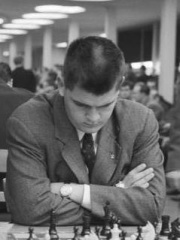
10. William Lombardy (1937 - 2017)
With an HPI of 55.31, William Lombardy is the 10th most famous American Chess Player. His biography has been translated into 18 different languages.
William James Joseph Lombardy (December 4, 1937 – October 13, 2017) was an American chess grandmaster, chess writer, teacher, and former Catholic priest. He was one of the leading American chess players during the 1950s and 1960s, and a contemporary of Bobby Fischer, whom he seconded during the World Chess Championship 1972. He won the World Junior Chess Championship in 1957, the only person to win that tournament with a perfect score. Lombardy led the U.S. Student Team to Gold in the 1960 World Student Team Championship in Leningrad.
People
Pantheon has 24 people classified as American chess players born between 1837 and 2009. Of these 24, 12 (50.00%) of them are still alive today. The most famous living American chess players include Nick de Firmian, Fabiano Caruana, and Joshua Waitzkin. The most famous deceased American chess players include Bobby Fischer, Frank Marshall, and Paul Morphy. As of April 2024, 3 new American chess players have been added to Pantheon including Joshua Waitzkin, Samuel Sevian, and Jeffery Xiong.
Living American Chess Players
Go to all RankingsNick de Firmian
1957 - Present
HPI: 54.06
Fabiano Caruana
1992 - Present
HPI: 50.75
Joshua Waitzkin
1976 - Present
HPI: 48.33
Levy Rozman
1995 - Present
HPI: 47.81
Hans Niemann
2003 - Present
HPI: 45.11
Joel Benjamin
1964 - Present
HPI: 43.32
Alexandra Botez
1995 - Present
HPI: 40.71
Sam Shankland
1991 - Present
HPI: 40.57
Jennifer Shahade
1980 - Present
HPI: 35.12
Abhimanyu Mishra
2009 - Present
HPI: 31.41
Samuel Sevian
2000 - Present
HPI: 29.17
Jeffery Xiong
2000 - Present
HPI: 25.98
Deceased American Chess Players
Go to all RankingsBobby Fischer
1943 - 2008
HPI: 78.36
Frank Marshall
1877 - 1944
HPI: 71.64
Paul Morphy
1837 - 1884
HPI: 71.03
Harry Nelson Pillsbury
1872 - 1906
HPI: 60.22
Larry Evans
1932 - 2010
HPI: 59.62
Reuben Fine
1914 - 1993
HPI: 58.96
Jackson Showalter
1860 - 1935
HPI: 58.94
Robert Byrne
1928 - 2013
HPI: 58.83
Israel Albert Horowitz
1907 - 1973
HPI: 58.42
William Lombardy
1937 - 2017
HPI: 55.31
Isaac Kashdan
1905 - 1985
HPI: 53.06
Arnold Denker
1914 - 2005
HPI: 52.89
Newly Added American Chess Players (2025)
Go to all RankingsJoshua Waitzkin
1976 - Present
HPI: 48.33
Samuel Sevian
2000 - Present
HPI: 29.17
Jeffery Xiong
2000 - Present
HPI: 25.98
Overlapping Lives
Which Chess Players were alive at the same time? This visualization shows the lifespans of the 12 most globally memorable Chess Players since 1700.

